Human Resource Management in Manufacturing: Employee Retention Focus
VerifiedAdded on 2023/06/05
|15
|4392
|382
Essay
AI Summary
This essay examines the critical role of human resource management (HRM) within the manufacturing sector, using Volkswagen as a case study to illustrate key challenges and strategies. It highlights the importance of HRM in fostering organizational development, particularly in light of a shrinking and aging workforce. The essay focuses on challenges such as attracting and retaining employees, addressing legal, ethical, and safety concerns, and promoting diversity and work-life balance. Employee retention and turnover are discussed as major responsibilities of the HR department, emphasizing the need for strategies like competitive compensation, incentives, and recognition. The significance of employee motivation through performance appraisal systems and various forms of compensation is also explored, alongside the implementation of effective performance management systems to enhance employee productivity and overall organizational performance. The essay also touches upon the importance of diversity, communication, and addressing financial insecurities to improve employee satisfaction and reduce turnover rates within manufacturing companies.
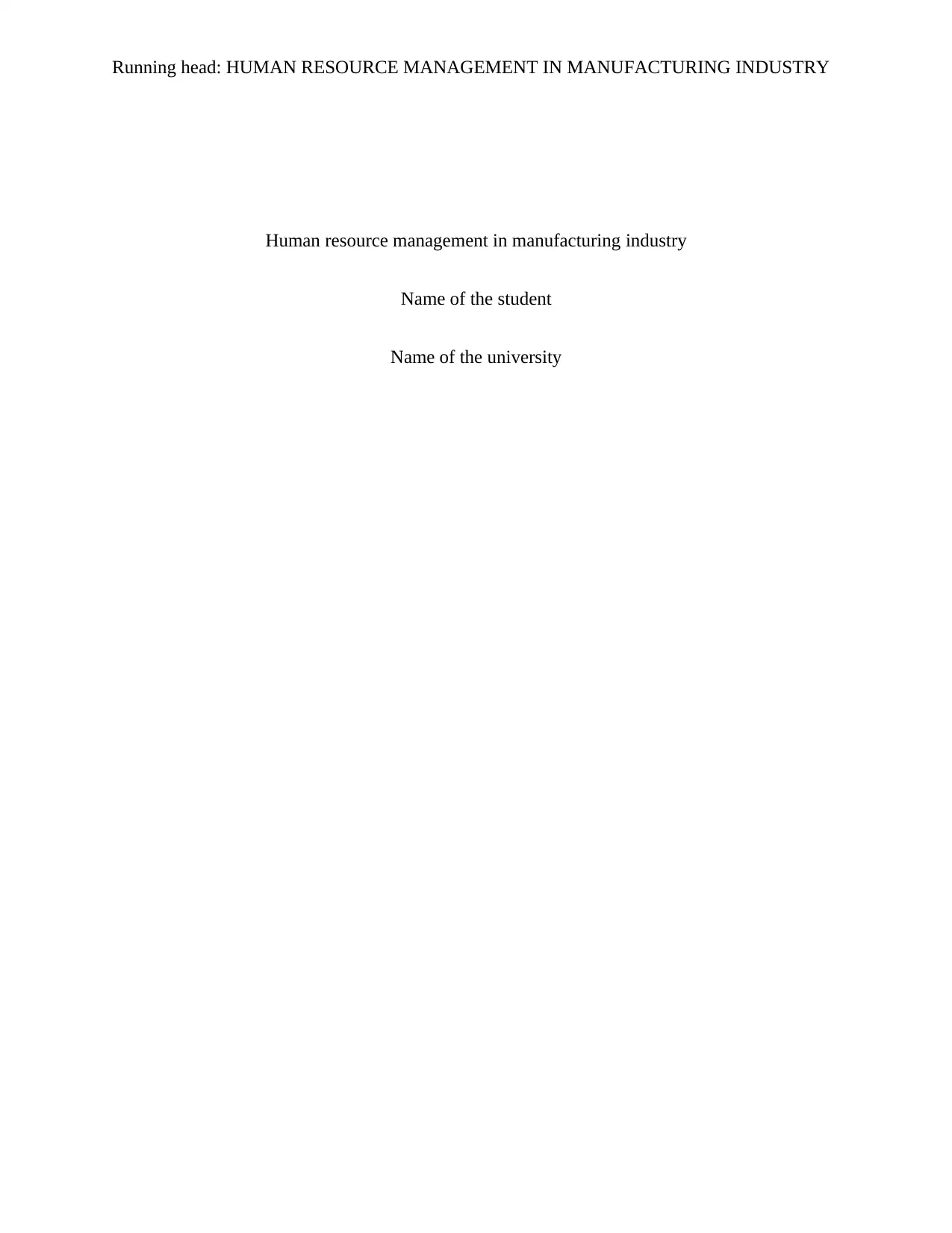
Running head: HUMAN RESOURCE MANAGEMENT IN MANUFACTURING INDUSTRY
Human resource management in manufacturing industry
Name of the student
Name of the university
Human resource management in manufacturing industry
Name of the student
Name of the university
Paraphrase This Document
Need a fresh take? Get an instant paraphrase of this document with our AI Paraphraser
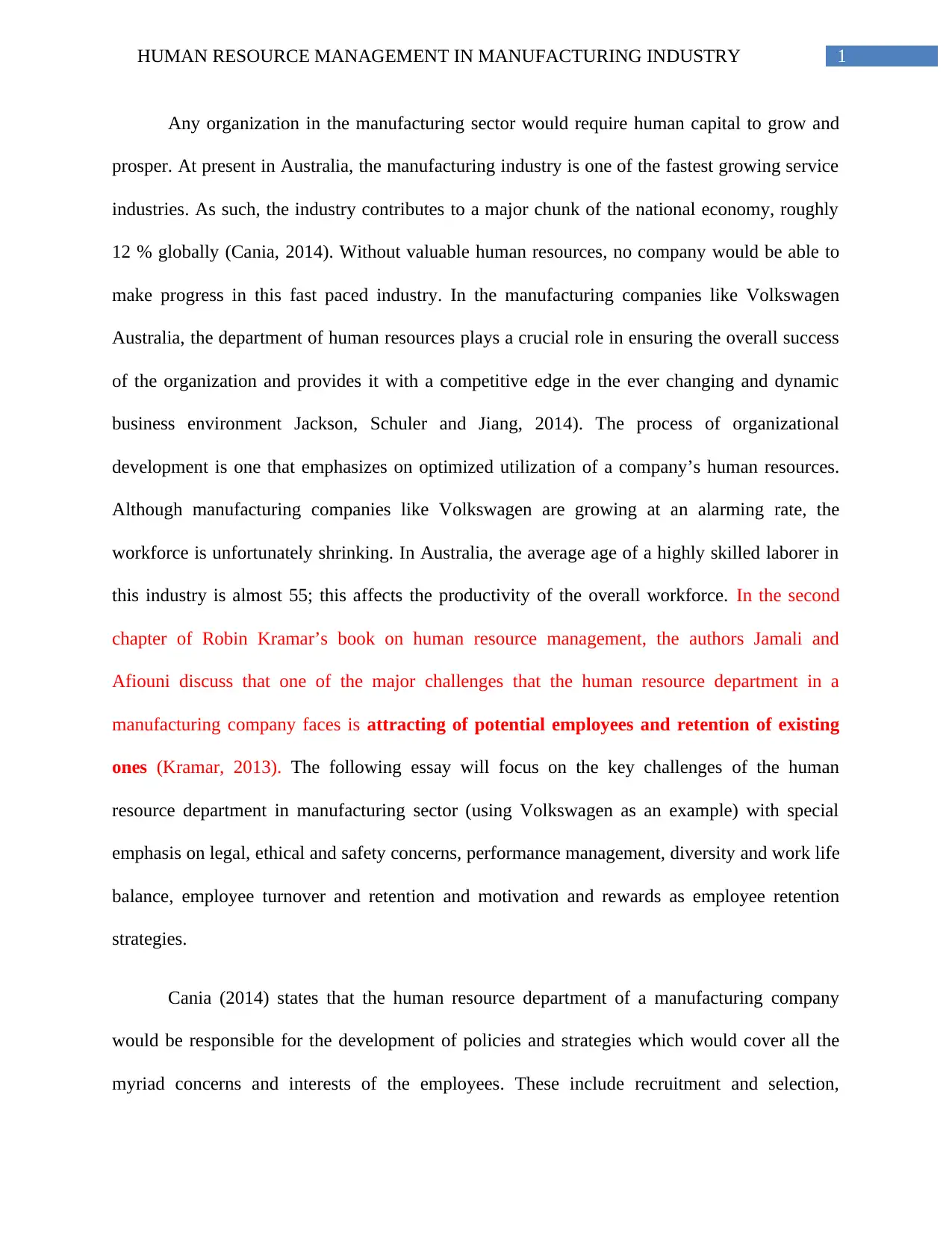
1HUMAN RESOURCE MANAGEMENT IN MANUFACTURING INDUSTRY
Any organization in the manufacturing sector would require human capital to grow and
prosper. At present in Australia, the manufacturing industry is one of the fastest growing service
industries. As such, the industry contributes to a major chunk of the national economy, roughly
12 % globally (Cania, 2014). Without valuable human resources, no company would be able to
make progress in this fast paced industry. In the manufacturing companies like Volkswagen
Australia, the department of human resources plays a crucial role in ensuring the overall success
of the organization and provides it with a competitive edge in the ever changing and dynamic
business environment Jackson, Schuler and Jiang, 2014). The process of organizational
development is one that emphasizes on optimized utilization of a company’s human resources.
Although manufacturing companies like Volkswagen are growing at an alarming rate, the
workforce is unfortunately shrinking. In Australia, the average age of a highly skilled laborer in
this industry is almost 55; this affects the productivity of the overall workforce. In the second
chapter of Robin Kramar’s book on human resource management, the authors Jamali and
Afiouni discuss that one of the major challenges that the human resource department in a
manufacturing company faces is attracting of potential employees and retention of existing
ones (Kramar, 2013). The following essay will focus on the key challenges of the human
resource department in manufacturing sector (using Volkswagen as an example) with special
emphasis on legal, ethical and safety concerns, performance management, diversity and work life
balance, employee turnover and retention and motivation and rewards as employee retention
strategies.
Cania (2014) states that the human resource department of a manufacturing company
would be responsible for the development of policies and strategies which would cover all the
myriad concerns and interests of the employees. These include recruitment and selection,
Any organization in the manufacturing sector would require human capital to grow and
prosper. At present in Australia, the manufacturing industry is one of the fastest growing service
industries. As such, the industry contributes to a major chunk of the national economy, roughly
12 % globally (Cania, 2014). Without valuable human resources, no company would be able to
make progress in this fast paced industry. In the manufacturing companies like Volkswagen
Australia, the department of human resources plays a crucial role in ensuring the overall success
of the organization and provides it with a competitive edge in the ever changing and dynamic
business environment Jackson, Schuler and Jiang, 2014). The process of organizational
development is one that emphasizes on optimized utilization of a company’s human resources.
Although manufacturing companies like Volkswagen are growing at an alarming rate, the
workforce is unfortunately shrinking. In Australia, the average age of a highly skilled laborer in
this industry is almost 55; this affects the productivity of the overall workforce. In the second
chapter of Robin Kramar’s book on human resource management, the authors Jamali and
Afiouni discuss that one of the major challenges that the human resource department in a
manufacturing company faces is attracting of potential employees and retention of existing
ones (Kramar, 2013). The following essay will focus on the key challenges of the human
resource department in manufacturing sector (using Volkswagen as an example) with special
emphasis on legal, ethical and safety concerns, performance management, diversity and work life
balance, employee turnover and retention and motivation and rewards as employee retention
strategies.
Cania (2014) states that the human resource department of a manufacturing company
would be responsible for the development of policies and strategies which would cover all the
myriad concerns and interests of the employees. These include recruitment and selection,
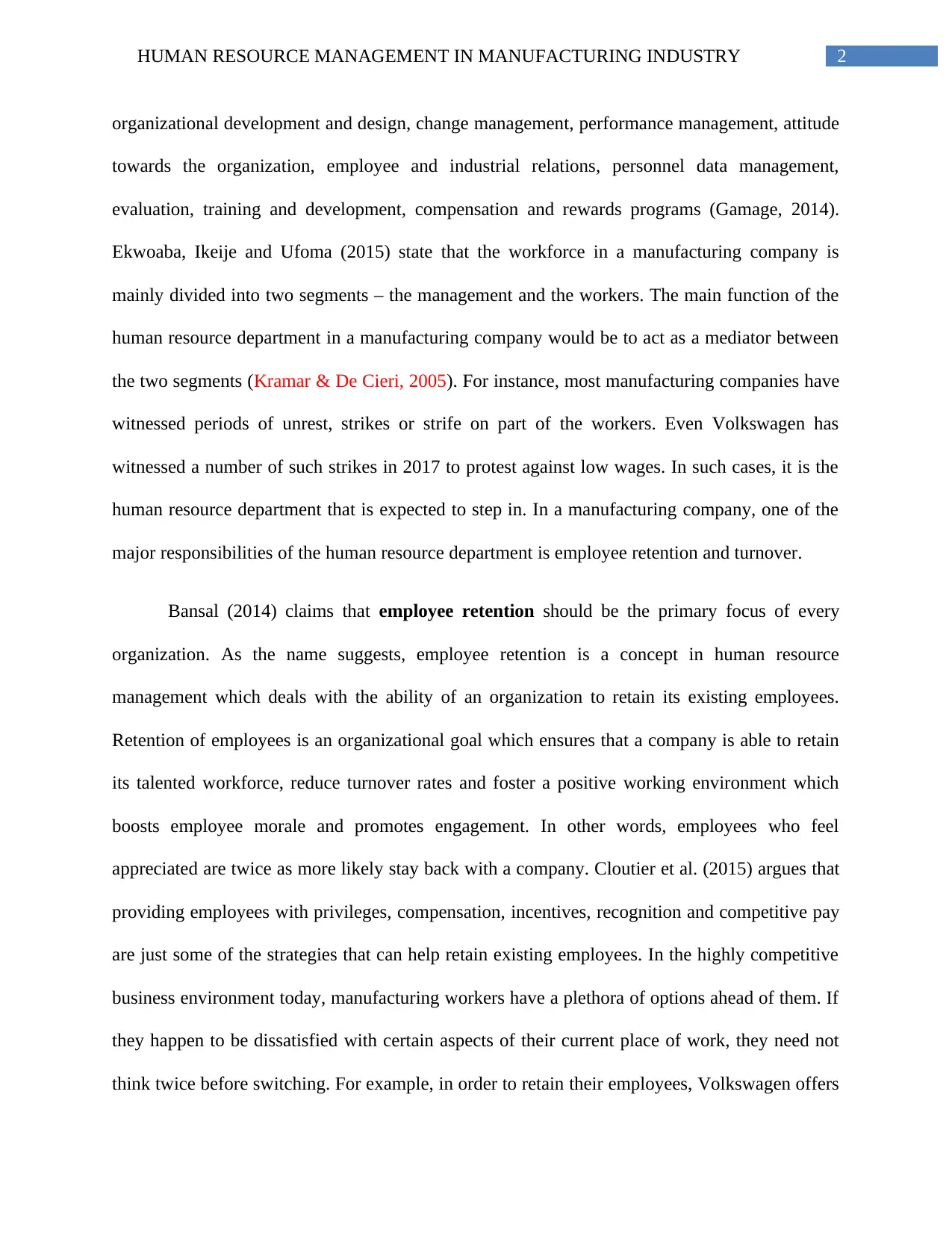
2HUMAN RESOURCE MANAGEMENT IN MANUFACTURING INDUSTRY
organizational development and design, change management, performance management, attitude
towards the organization, employee and industrial relations, personnel data management,
evaluation, training and development, compensation and rewards programs (Gamage, 2014).
Ekwoaba, Ikeije and Ufoma (2015) state that the workforce in a manufacturing company is
mainly divided into two segments – the management and the workers. The main function of the
human resource department in a manufacturing company would be to act as a mediator between
the two segments (Kramar & De Cieri, 2005). For instance, most manufacturing companies have
witnessed periods of unrest, strikes or strife on part of the workers. Even Volkswagen has
witnessed a number of such strikes in 2017 to protest against low wages. In such cases, it is the
human resource department that is expected to step in. In a manufacturing company, one of the
major responsibilities of the human resource department is employee retention and turnover.
Bansal (2014) claims that employee retention should be the primary focus of every
organization. As the name suggests, employee retention is a concept in human resource
management which deals with the ability of an organization to retain its existing employees.
Retention of employees is an organizational goal which ensures that a company is able to retain
its talented workforce, reduce turnover rates and foster a positive working environment which
boosts employee morale and promotes engagement. In other words, employees who feel
appreciated are twice as more likely stay back with a company. Cloutier et al. (2015) argues that
providing employees with privileges, compensation, incentives, recognition and competitive pay
are just some of the strategies that can help retain existing employees. In the highly competitive
business environment today, manufacturing workers have a plethora of options ahead of them. If
they happen to be dissatisfied with certain aspects of their current place of work, they need not
think twice before switching. For example, in order to retain their employees, Volkswagen offers
organizational development and design, change management, performance management, attitude
towards the organization, employee and industrial relations, personnel data management,
evaluation, training and development, compensation and rewards programs (Gamage, 2014).
Ekwoaba, Ikeije and Ufoma (2015) state that the workforce in a manufacturing company is
mainly divided into two segments – the management and the workers. The main function of the
human resource department in a manufacturing company would be to act as a mediator between
the two segments (Kramar & De Cieri, 2005). For instance, most manufacturing companies have
witnessed periods of unrest, strikes or strife on part of the workers. Even Volkswagen has
witnessed a number of such strikes in 2017 to protest against low wages. In such cases, it is the
human resource department that is expected to step in. In a manufacturing company, one of the
major responsibilities of the human resource department is employee retention and turnover.
Bansal (2014) claims that employee retention should be the primary focus of every
organization. As the name suggests, employee retention is a concept in human resource
management which deals with the ability of an organization to retain its existing employees.
Retention of employees is an organizational goal which ensures that a company is able to retain
its talented workforce, reduce turnover rates and foster a positive working environment which
boosts employee morale and promotes engagement. In other words, employees who feel
appreciated are twice as more likely stay back with a company. Cloutier et al. (2015) argues that
providing employees with privileges, compensation, incentives, recognition and competitive pay
are just some of the strategies that can help retain existing employees. In the highly competitive
business environment today, manufacturing workers have a plethora of options ahead of them. If
they happen to be dissatisfied with certain aspects of their current place of work, they need not
think twice before switching. For example, in order to retain their employees, Volkswagen offers
⊘ This is a preview!⊘
Do you want full access?
Subscribe today to unlock all pages.

Trusted by 1+ million students worldwide
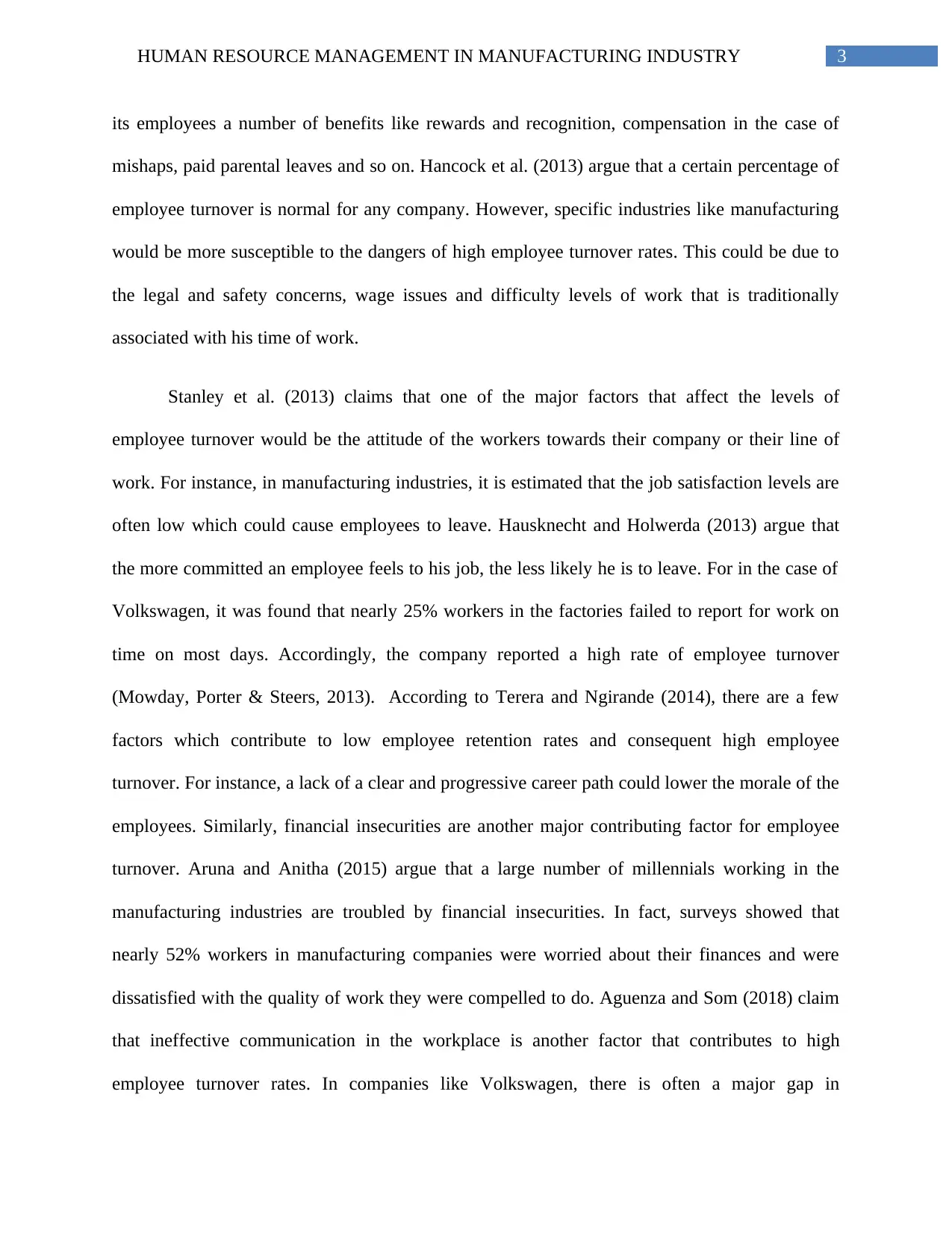
3HUMAN RESOURCE MANAGEMENT IN MANUFACTURING INDUSTRY
its employees a number of benefits like rewards and recognition, compensation in the case of
mishaps, paid parental leaves and so on. Hancock et al. (2013) argue that a certain percentage of
employee turnover is normal for any company. However, specific industries like manufacturing
would be more susceptible to the dangers of high employee turnover rates. This could be due to
the legal and safety concerns, wage issues and difficulty levels of work that is traditionally
associated with his time of work.
Stanley et al. (2013) claims that one of the major factors that affect the levels of
employee turnover would be the attitude of the workers towards their company or their line of
work. For instance, in manufacturing industries, it is estimated that the job satisfaction levels are
often low which could cause employees to leave. Hausknecht and Holwerda (2013) argue that
the more committed an employee feels to his job, the less likely he is to leave. For in the case of
Volkswagen, it was found that nearly 25% workers in the factories failed to report for work on
time on most days. Accordingly, the company reported a high rate of employee turnover
(Mowday, Porter & Steers, 2013). According to Terera and Ngirande (2014), there are a few
factors which contribute to low employee retention rates and consequent high employee
turnover. For instance, a lack of a clear and progressive career path could lower the morale of the
employees. Similarly, financial insecurities are another major contributing factor for employee
turnover. Aruna and Anitha (2015) argue that a large number of millennials working in the
manufacturing industries are troubled by financial insecurities. In fact, surveys showed that
nearly 52% workers in manufacturing companies were worried about their finances and were
dissatisfied with the quality of work they were compelled to do. Aguenza and Som (2018) claim
that ineffective communication in the workplace is another factor that contributes to high
employee turnover rates. In companies like Volkswagen, there is often a major gap in
its employees a number of benefits like rewards and recognition, compensation in the case of
mishaps, paid parental leaves and so on. Hancock et al. (2013) argue that a certain percentage of
employee turnover is normal for any company. However, specific industries like manufacturing
would be more susceptible to the dangers of high employee turnover rates. This could be due to
the legal and safety concerns, wage issues and difficulty levels of work that is traditionally
associated with his time of work.
Stanley et al. (2013) claims that one of the major factors that affect the levels of
employee turnover would be the attitude of the workers towards their company or their line of
work. For instance, in manufacturing industries, it is estimated that the job satisfaction levels are
often low which could cause employees to leave. Hausknecht and Holwerda (2013) argue that
the more committed an employee feels to his job, the less likely he is to leave. For in the case of
Volkswagen, it was found that nearly 25% workers in the factories failed to report for work on
time on most days. Accordingly, the company reported a high rate of employee turnover
(Mowday, Porter & Steers, 2013). According to Terera and Ngirande (2014), there are a few
factors which contribute to low employee retention rates and consequent high employee
turnover. For instance, a lack of a clear and progressive career path could lower the morale of the
employees. Similarly, financial insecurities are another major contributing factor for employee
turnover. Aruna and Anitha (2015) argue that a large number of millennials working in the
manufacturing industries are troubled by financial insecurities. In fact, surveys showed that
nearly 52% workers in manufacturing companies were worried about their finances and were
dissatisfied with the quality of work they were compelled to do. Aguenza and Som (2018) claim
that ineffective communication in the workplace is another factor that contributes to high
employee turnover rates. In companies like Volkswagen, there is often a major gap in
Paraphrase This Document
Need a fresh take? Get an instant paraphrase of this document with our AI Paraphraser
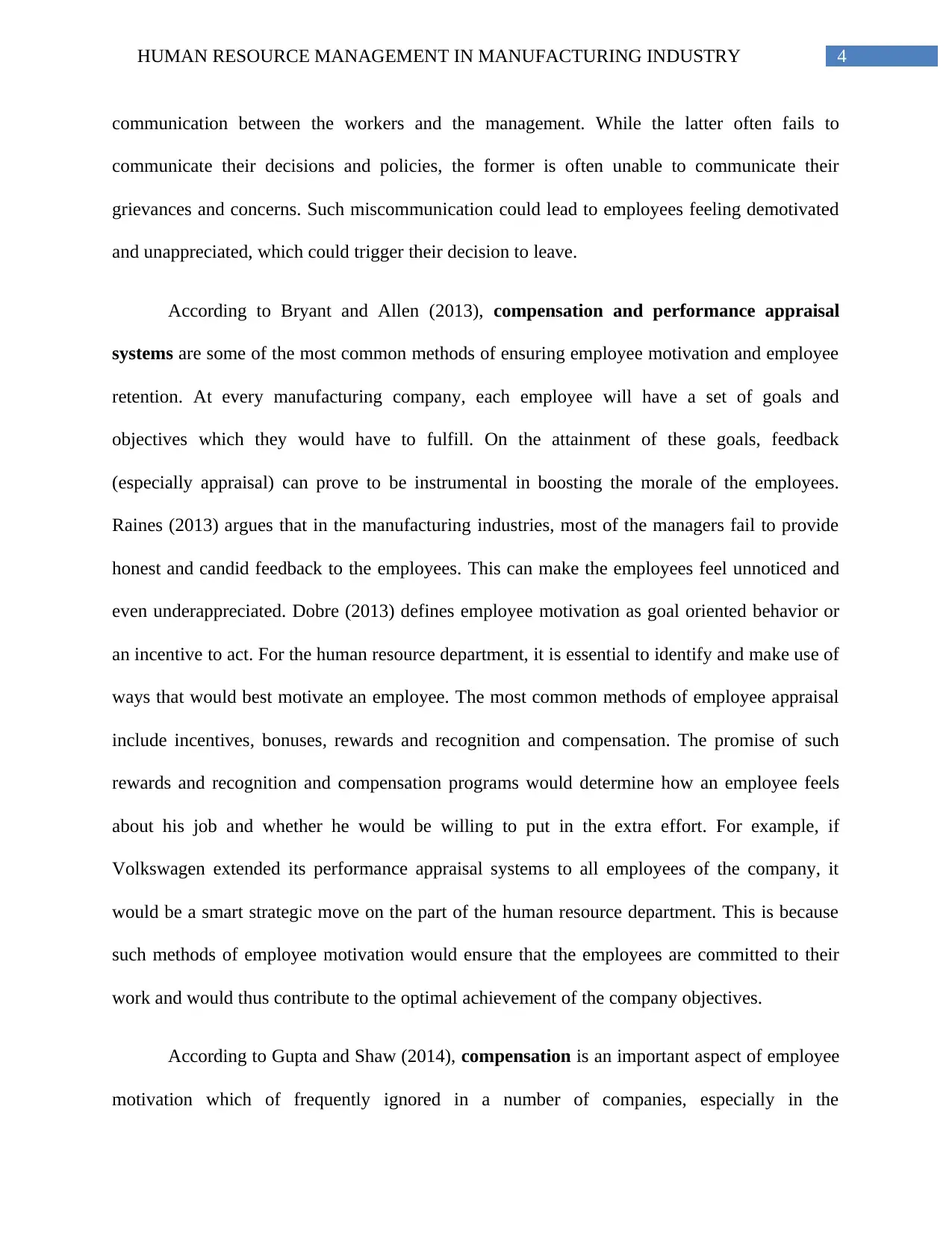
4HUMAN RESOURCE MANAGEMENT IN MANUFACTURING INDUSTRY
communication between the workers and the management. While the latter often fails to
communicate their decisions and policies, the former is often unable to communicate their
grievances and concerns. Such miscommunication could lead to employees feeling demotivated
and unappreciated, which could trigger their decision to leave.
According to Bryant and Allen (2013), compensation and performance appraisal
systems are some of the most common methods of ensuring employee motivation and employee
retention. At every manufacturing company, each employee will have a set of goals and
objectives which they would have to fulfill. On the attainment of these goals, feedback
(especially appraisal) can prove to be instrumental in boosting the morale of the employees.
Raines (2013) argues that in the manufacturing industries, most of the managers fail to provide
honest and candid feedback to the employees. This can make the employees feel unnoticed and
even underappreciated. Dobre (2013) defines employee motivation as goal oriented behavior or
an incentive to act. For the human resource department, it is essential to identify and make use of
ways that would best motivate an employee. The most common methods of employee appraisal
include incentives, bonuses, rewards and recognition and compensation. The promise of such
rewards and recognition and compensation programs would determine how an employee feels
about his job and whether he would be willing to put in the extra effort. For example, if
Volkswagen extended its performance appraisal systems to all employees of the company, it
would be a smart strategic move on the part of the human resource department. This is because
such methods of employee motivation would ensure that the employees are committed to their
work and would thus contribute to the optimal achievement of the company objectives.
According to Gupta and Shaw (2014), compensation is an important aspect of employee
motivation which of frequently ignored in a number of companies, especially in the
communication between the workers and the management. While the latter often fails to
communicate their decisions and policies, the former is often unable to communicate their
grievances and concerns. Such miscommunication could lead to employees feeling demotivated
and unappreciated, which could trigger their decision to leave.
According to Bryant and Allen (2013), compensation and performance appraisal
systems are some of the most common methods of ensuring employee motivation and employee
retention. At every manufacturing company, each employee will have a set of goals and
objectives which they would have to fulfill. On the attainment of these goals, feedback
(especially appraisal) can prove to be instrumental in boosting the morale of the employees.
Raines (2013) argues that in the manufacturing industries, most of the managers fail to provide
honest and candid feedback to the employees. This can make the employees feel unnoticed and
even underappreciated. Dobre (2013) defines employee motivation as goal oriented behavior or
an incentive to act. For the human resource department, it is essential to identify and make use of
ways that would best motivate an employee. The most common methods of employee appraisal
include incentives, bonuses, rewards and recognition and compensation. The promise of such
rewards and recognition and compensation programs would determine how an employee feels
about his job and whether he would be willing to put in the extra effort. For example, if
Volkswagen extended its performance appraisal systems to all employees of the company, it
would be a smart strategic move on the part of the human resource department. This is because
such methods of employee motivation would ensure that the employees are committed to their
work and would thus contribute to the optimal achievement of the company objectives.
According to Gupta and Shaw (2014), compensation is an important aspect of employee
motivation which of frequently ignored in a number of companies, especially in the
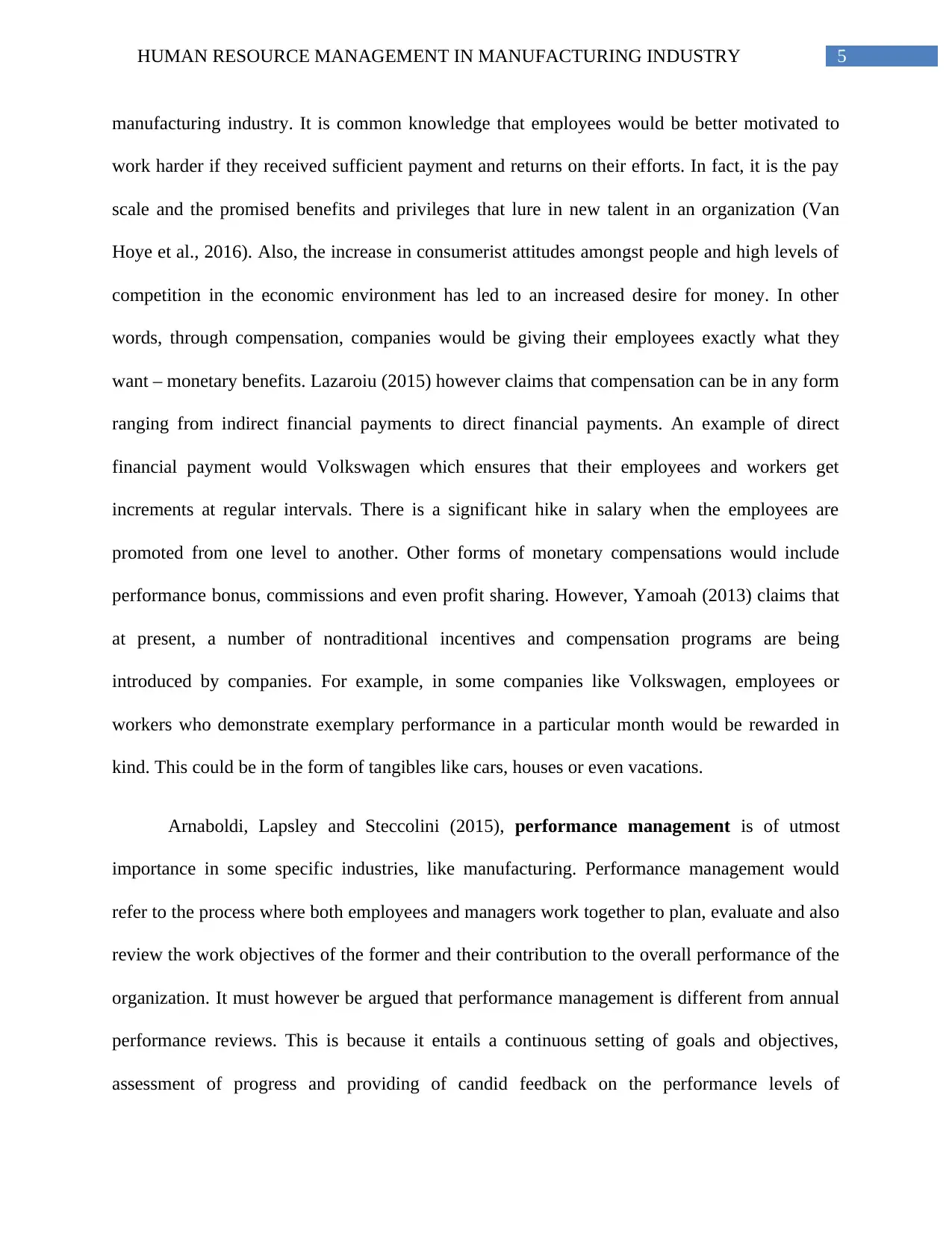
5HUMAN RESOURCE MANAGEMENT IN MANUFACTURING INDUSTRY
manufacturing industry. It is common knowledge that employees would be better motivated to
work harder if they received sufficient payment and returns on their efforts. In fact, it is the pay
scale and the promised benefits and privileges that lure in new talent in an organization (Van
Hoye et al., 2016). Also, the increase in consumerist attitudes amongst people and high levels of
competition in the economic environment has led to an increased desire for money. In other
words, through compensation, companies would be giving their employees exactly what they
want – monetary benefits. Lazaroiu (2015) however claims that compensation can be in any form
ranging from indirect financial payments to direct financial payments. An example of direct
financial payment would Volkswagen which ensures that their employees and workers get
increments at regular intervals. There is a significant hike in salary when the employees are
promoted from one level to another. Other forms of monetary compensations would include
performance bonus, commissions and even profit sharing. However, Yamoah (2013) claims that
at present, a number of nontraditional incentives and compensation programs are being
introduced by companies. For example, in some companies like Volkswagen, employees or
workers who demonstrate exemplary performance in a particular month would be rewarded in
kind. This could be in the form of tangibles like cars, houses or even vacations.
Arnaboldi, Lapsley and Steccolini (2015), performance management is of utmost
importance in some specific industries, like manufacturing. Performance management would
refer to the process where both employees and managers work together to plan, evaluate and also
review the work objectives of the former and their contribution to the overall performance of the
organization. It must however be argued that performance management is different from annual
performance reviews. This is because it entails a continuous setting of goals and objectives,
assessment of progress and providing of candid feedback on the performance levels of
manufacturing industry. It is common knowledge that employees would be better motivated to
work harder if they received sufficient payment and returns on their efforts. In fact, it is the pay
scale and the promised benefits and privileges that lure in new talent in an organization (Van
Hoye et al., 2016). Also, the increase in consumerist attitudes amongst people and high levels of
competition in the economic environment has led to an increased desire for money. In other
words, through compensation, companies would be giving their employees exactly what they
want – monetary benefits. Lazaroiu (2015) however claims that compensation can be in any form
ranging from indirect financial payments to direct financial payments. An example of direct
financial payment would Volkswagen which ensures that their employees and workers get
increments at regular intervals. There is a significant hike in salary when the employees are
promoted from one level to another. Other forms of monetary compensations would include
performance bonus, commissions and even profit sharing. However, Yamoah (2013) claims that
at present, a number of nontraditional incentives and compensation programs are being
introduced by companies. For example, in some companies like Volkswagen, employees or
workers who demonstrate exemplary performance in a particular month would be rewarded in
kind. This could be in the form of tangibles like cars, houses or even vacations.
Arnaboldi, Lapsley and Steccolini (2015), performance management is of utmost
importance in some specific industries, like manufacturing. Performance management would
refer to the process where both employees and managers work together to plan, evaluate and also
review the work objectives of the former and their contribution to the overall performance of the
organization. It must however be argued that performance management is different from annual
performance reviews. This is because it entails a continuous setting of goals and objectives,
assessment of progress and providing of candid feedback on the performance levels of
⊘ This is a preview!⊘
Do you want full access?
Subscribe today to unlock all pages.

Trusted by 1+ million students worldwide
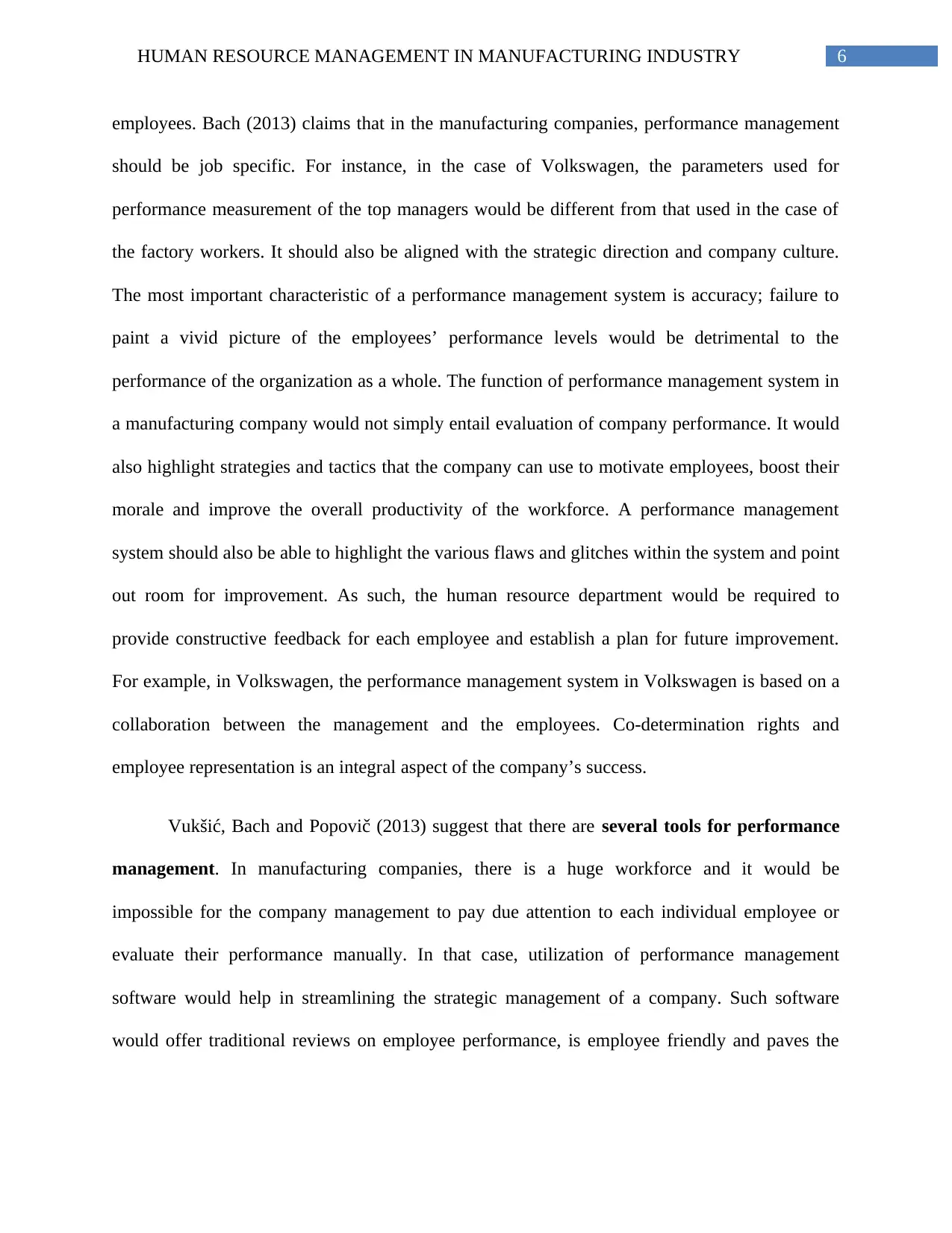
6HUMAN RESOURCE MANAGEMENT IN MANUFACTURING INDUSTRY
employees. Bach (2013) claims that in the manufacturing companies, performance management
should be job specific. For instance, in the case of Volkswagen, the parameters used for
performance measurement of the top managers would be different from that used in the case of
the factory workers. It should also be aligned with the strategic direction and company culture.
The most important characteristic of a performance management system is accuracy; failure to
paint a vivid picture of the employees’ performance levels would be detrimental to the
performance of the organization as a whole. The function of performance management system in
a manufacturing company would not simply entail evaluation of company performance. It would
also highlight strategies and tactics that the company can use to motivate employees, boost their
morale and improve the overall productivity of the workforce. A performance management
system should also be able to highlight the various flaws and glitches within the system and point
out room for improvement. As such, the human resource department would be required to
provide constructive feedback for each employee and establish a plan for future improvement.
For example, in Volkswagen, the performance management system in Volkswagen is based on a
collaboration between the management and the employees. Co-determination rights and
employee representation is an integral aspect of the company’s success.
Vukšić, Bach and Popovič (2013) suggest that there are several tools for performance
management. In manufacturing companies, there is a huge workforce and it would be
impossible for the company management to pay due attention to each individual employee or
evaluate their performance manually. In that case, utilization of performance management
software would help in streamlining the strategic management of a company. Such software
would offer traditional reviews on employee performance, is employee friendly and paves the
employees. Bach (2013) claims that in the manufacturing companies, performance management
should be job specific. For instance, in the case of Volkswagen, the parameters used for
performance measurement of the top managers would be different from that used in the case of
the factory workers. It should also be aligned with the strategic direction and company culture.
The most important characteristic of a performance management system is accuracy; failure to
paint a vivid picture of the employees’ performance levels would be detrimental to the
performance of the organization as a whole. The function of performance management system in
a manufacturing company would not simply entail evaluation of company performance. It would
also highlight strategies and tactics that the company can use to motivate employees, boost their
morale and improve the overall productivity of the workforce. A performance management
system should also be able to highlight the various flaws and glitches within the system and point
out room for improvement. As such, the human resource department would be required to
provide constructive feedback for each employee and establish a plan for future improvement.
For example, in Volkswagen, the performance management system in Volkswagen is based on a
collaboration between the management and the employees. Co-determination rights and
employee representation is an integral aspect of the company’s success.
Vukšić, Bach and Popovič (2013) suggest that there are several tools for performance
management. In manufacturing companies, there is a huge workforce and it would be
impossible for the company management to pay due attention to each individual employee or
evaluate their performance manually. In that case, utilization of performance management
software would help in streamlining the strategic management of a company. Such software
would offer traditional reviews on employee performance, is employee friendly and paves the
Paraphrase This Document
Need a fresh take? Get an instant paraphrase of this document with our AI Paraphraser
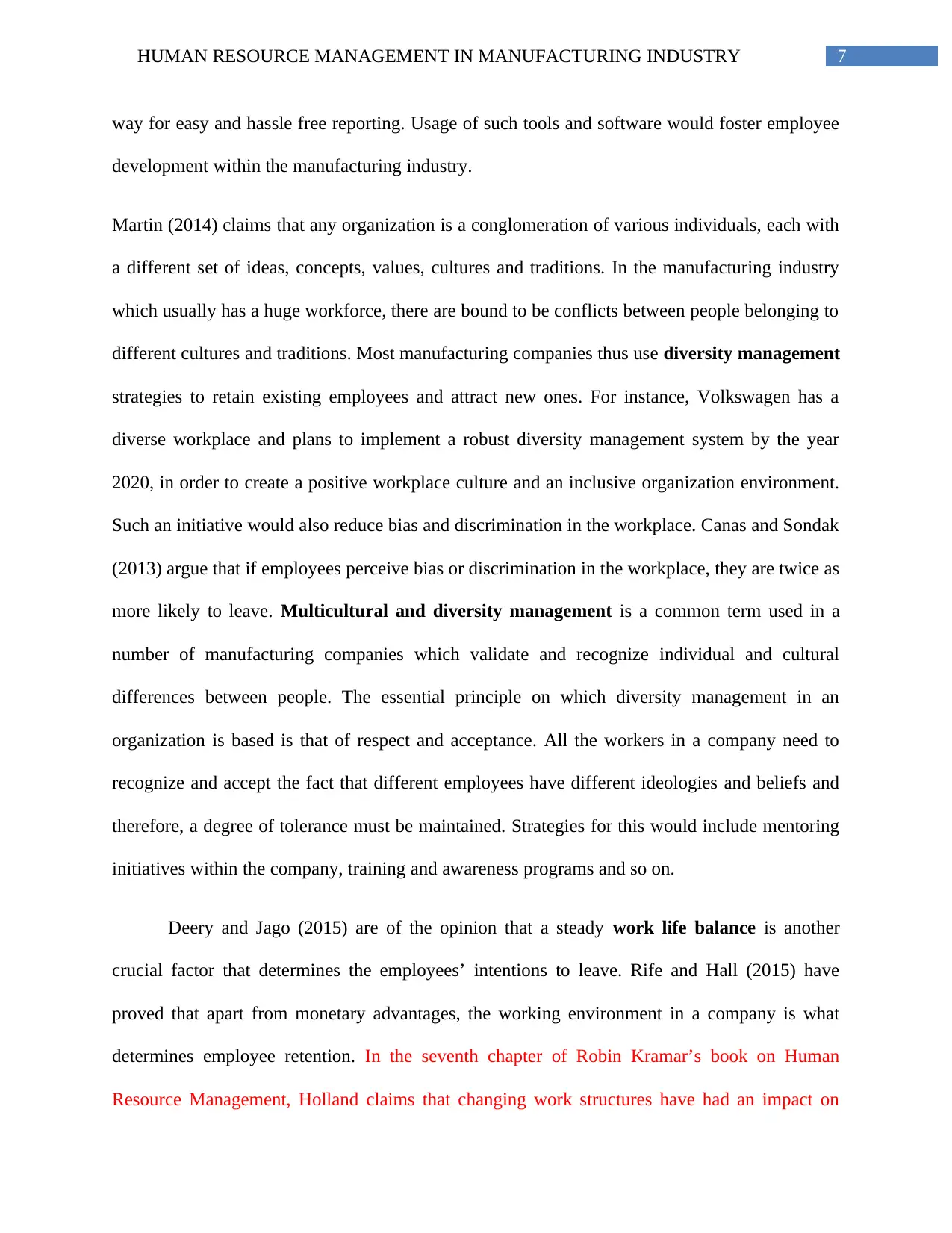
7HUMAN RESOURCE MANAGEMENT IN MANUFACTURING INDUSTRY
way for easy and hassle free reporting. Usage of such tools and software would foster employee
development within the manufacturing industry.
Martin (2014) claims that any organization is a conglomeration of various individuals, each with
a different set of ideas, concepts, values, cultures and traditions. In the manufacturing industry
which usually has a huge workforce, there are bound to be conflicts between people belonging to
different cultures and traditions. Most manufacturing companies thus use diversity management
strategies to retain existing employees and attract new ones. For instance, Volkswagen has a
diverse workplace and plans to implement a robust diversity management system by the year
2020, in order to create a positive workplace culture and an inclusive organization environment.
Such an initiative would also reduce bias and discrimination in the workplace. Canas and Sondak
(2013) argue that if employees perceive bias or discrimination in the workplace, they are twice as
more likely to leave. Multicultural and diversity management is a common term used in a
number of manufacturing companies which validate and recognize individual and cultural
differences between people. The essential principle on which diversity management in an
organization is based is that of respect and acceptance. All the workers in a company need to
recognize and accept the fact that different employees have different ideologies and beliefs and
therefore, a degree of tolerance must be maintained. Strategies for this would include mentoring
initiatives within the company, training and awareness programs and so on.
Deery and Jago (2015) are of the opinion that a steady work life balance is another
crucial factor that determines the employees’ intentions to leave. Rife and Hall (2015) have
proved that apart from monetary advantages, the working environment in a company is what
determines employee retention. In the seventh chapter of Robin Kramar’s book on Human
Resource Management, Holland claims that changing work structures have had an impact on
way for easy and hassle free reporting. Usage of such tools and software would foster employee
development within the manufacturing industry.
Martin (2014) claims that any organization is a conglomeration of various individuals, each with
a different set of ideas, concepts, values, cultures and traditions. In the manufacturing industry
which usually has a huge workforce, there are bound to be conflicts between people belonging to
different cultures and traditions. Most manufacturing companies thus use diversity management
strategies to retain existing employees and attract new ones. For instance, Volkswagen has a
diverse workplace and plans to implement a robust diversity management system by the year
2020, in order to create a positive workplace culture and an inclusive organization environment.
Such an initiative would also reduce bias and discrimination in the workplace. Canas and Sondak
(2013) argue that if employees perceive bias or discrimination in the workplace, they are twice as
more likely to leave. Multicultural and diversity management is a common term used in a
number of manufacturing companies which validate and recognize individual and cultural
differences between people. The essential principle on which diversity management in an
organization is based is that of respect and acceptance. All the workers in a company need to
recognize and accept the fact that different employees have different ideologies and beliefs and
therefore, a degree of tolerance must be maintained. Strategies for this would include mentoring
initiatives within the company, training and awareness programs and so on.
Deery and Jago (2015) are of the opinion that a steady work life balance is another
crucial factor that determines the employees’ intentions to leave. Rife and Hall (2015) have
proved that apart from monetary advantages, the working environment in a company is what
determines employee retention. In the seventh chapter of Robin Kramar’s book on Human
Resource Management, Holland claims that changing work structures have had an impact on
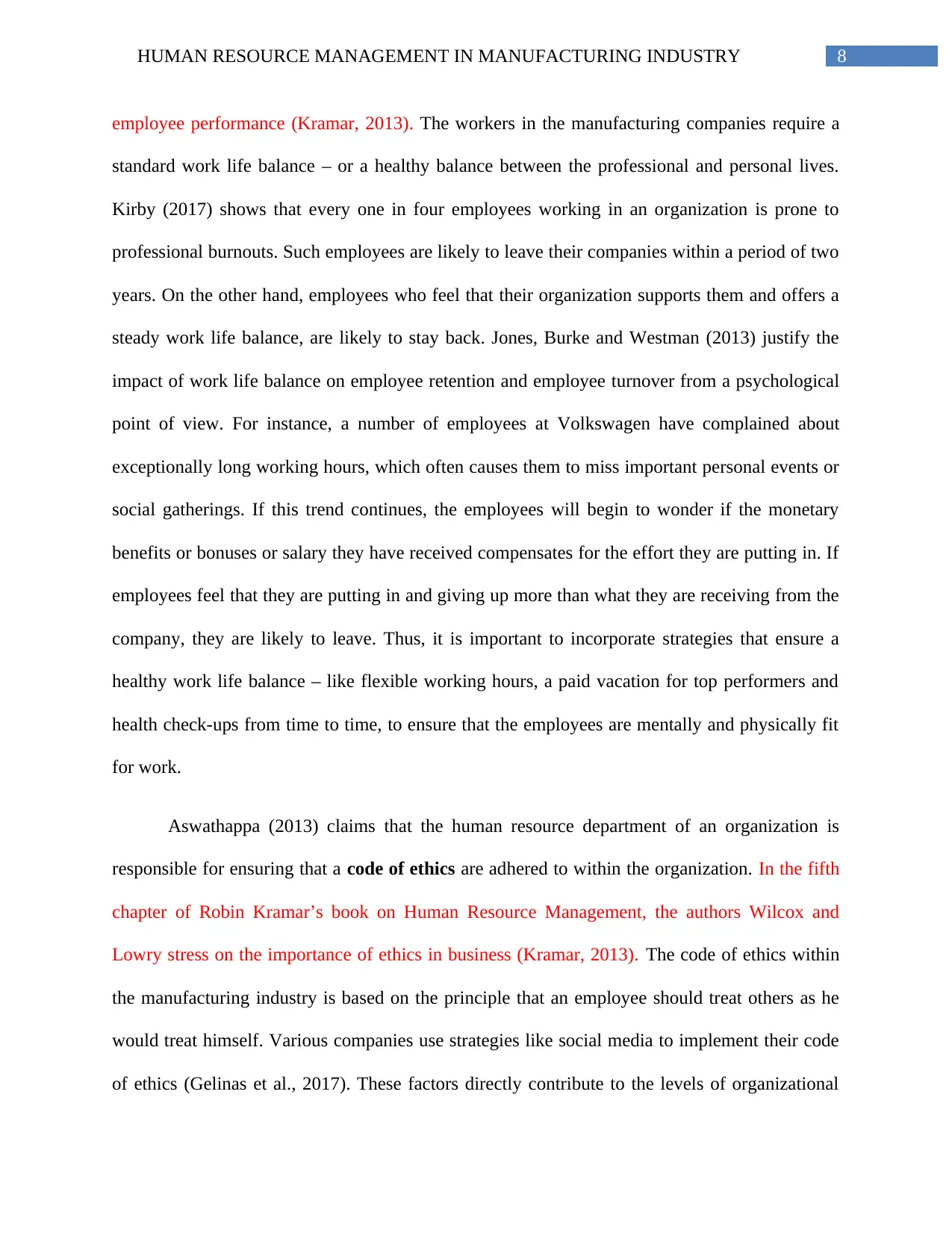
8HUMAN RESOURCE MANAGEMENT IN MANUFACTURING INDUSTRY
employee performance (Kramar, 2013). The workers in the manufacturing companies require a
standard work life balance – or a healthy balance between the professional and personal lives.
Kirby (2017) shows that every one in four employees working in an organization is prone to
professional burnouts. Such employees are likely to leave their companies within a period of two
years. On the other hand, employees who feel that their organization supports them and offers a
steady work life balance, are likely to stay back. Jones, Burke and Westman (2013) justify the
impact of work life balance on employee retention and employee turnover from a psychological
point of view. For instance, a number of employees at Volkswagen have complained about
exceptionally long working hours, which often causes them to miss important personal events or
social gatherings. If this trend continues, the employees will begin to wonder if the monetary
benefits or bonuses or salary they have received compensates for the effort they are putting in. If
employees feel that they are putting in and giving up more than what they are receiving from the
company, they are likely to leave. Thus, it is important to incorporate strategies that ensure a
healthy work life balance – like flexible working hours, a paid vacation for top performers and
health check-ups from time to time, to ensure that the employees are mentally and physically fit
for work.
Aswathappa (2013) claims that the human resource department of an organization is
responsible for ensuring that a code of ethics are adhered to within the organization. In the fifth
chapter of Robin Kramar’s book on Human Resource Management, the authors Wilcox and
Lowry stress on the importance of ethics in business (Kramar, 2013). The code of ethics within
the manufacturing industry is based on the principle that an employee should treat others as he
would treat himself. Various companies use strategies like social media to implement their code
of ethics (Gelinas et al., 2017). These factors directly contribute to the levels of organizational
employee performance (Kramar, 2013). The workers in the manufacturing companies require a
standard work life balance – or a healthy balance between the professional and personal lives.
Kirby (2017) shows that every one in four employees working in an organization is prone to
professional burnouts. Such employees are likely to leave their companies within a period of two
years. On the other hand, employees who feel that their organization supports them and offers a
steady work life balance, are likely to stay back. Jones, Burke and Westman (2013) justify the
impact of work life balance on employee retention and employee turnover from a psychological
point of view. For instance, a number of employees at Volkswagen have complained about
exceptionally long working hours, which often causes them to miss important personal events or
social gatherings. If this trend continues, the employees will begin to wonder if the monetary
benefits or bonuses or salary they have received compensates for the effort they are putting in. If
employees feel that they are putting in and giving up more than what they are receiving from the
company, they are likely to leave. Thus, it is important to incorporate strategies that ensure a
healthy work life balance – like flexible working hours, a paid vacation for top performers and
health check-ups from time to time, to ensure that the employees are mentally and physically fit
for work.
Aswathappa (2013) claims that the human resource department of an organization is
responsible for ensuring that a code of ethics are adhered to within the organization. In the fifth
chapter of Robin Kramar’s book on Human Resource Management, the authors Wilcox and
Lowry stress on the importance of ethics in business (Kramar, 2013). The code of ethics within
the manufacturing industry is based on the principle that an employee should treat others as he
would treat himself. Various companies use strategies like social media to implement their code
of ethics (Gelinas et al., 2017). These factors directly contribute to the levels of organizational
⊘ This is a preview!⊘
Do you want full access?
Subscribe today to unlock all pages.

Trusted by 1+ million students worldwide
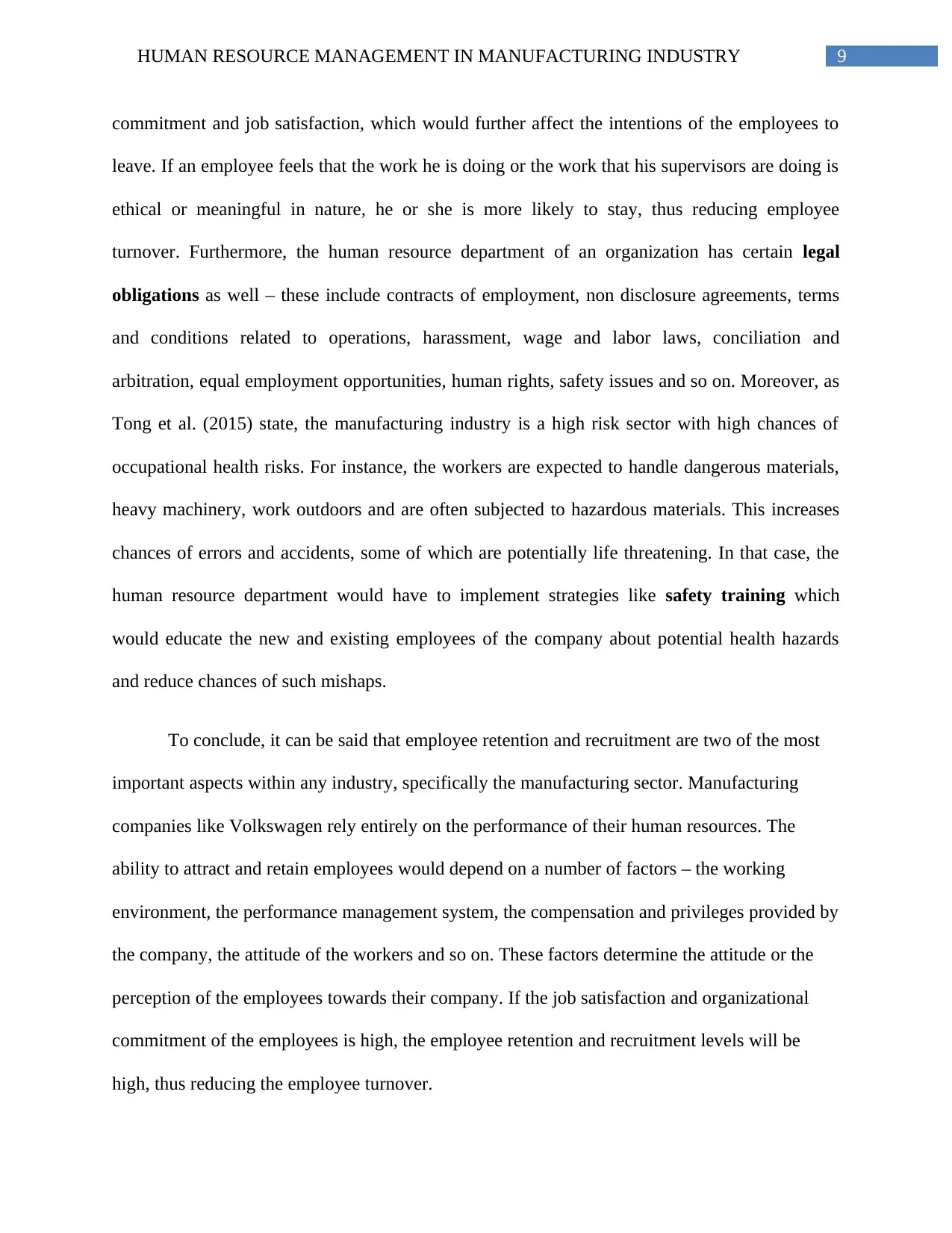
9HUMAN RESOURCE MANAGEMENT IN MANUFACTURING INDUSTRY
commitment and job satisfaction, which would further affect the intentions of the employees to
leave. If an employee feels that the work he is doing or the work that his supervisors are doing is
ethical or meaningful in nature, he or she is more likely to stay, thus reducing employee
turnover. Furthermore, the human resource department of an organization has certain legal
obligations as well – these include contracts of employment, non disclosure agreements, terms
and conditions related to operations, harassment, wage and labor laws, conciliation and
arbitration, equal employment opportunities, human rights, safety issues and so on. Moreover, as
Tong et al. (2015) state, the manufacturing industry is a high risk sector with high chances of
occupational health risks. For instance, the workers are expected to handle dangerous materials,
heavy machinery, work outdoors and are often subjected to hazardous materials. This increases
chances of errors and accidents, some of which are potentially life threatening. In that case, the
human resource department would have to implement strategies like safety training which
would educate the new and existing employees of the company about potential health hazards
and reduce chances of such mishaps.
To conclude, it can be said that employee retention and recruitment are two of the most
important aspects within any industry, specifically the manufacturing sector. Manufacturing
companies like Volkswagen rely entirely on the performance of their human resources. The
ability to attract and retain employees would depend on a number of factors – the working
environment, the performance management system, the compensation and privileges provided by
the company, the attitude of the workers and so on. These factors determine the attitude or the
perception of the employees towards their company. If the job satisfaction and organizational
commitment of the employees is high, the employee retention and recruitment levels will be
high, thus reducing the employee turnover.
commitment and job satisfaction, which would further affect the intentions of the employees to
leave. If an employee feels that the work he is doing or the work that his supervisors are doing is
ethical or meaningful in nature, he or she is more likely to stay, thus reducing employee
turnover. Furthermore, the human resource department of an organization has certain legal
obligations as well – these include contracts of employment, non disclosure agreements, terms
and conditions related to operations, harassment, wage and labor laws, conciliation and
arbitration, equal employment opportunities, human rights, safety issues and so on. Moreover, as
Tong et al. (2015) state, the manufacturing industry is a high risk sector with high chances of
occupational health risks. For instance, the workers are expected to handle dangerous materials,
heavy machinery, work outdoors and are often subjected to hazardous materials. This increases
chances of errors and accidents, some of which are potentially life threatening. In that case, the
human resource department would have to implement strategies like safety training which
would educate the new and existing employees of the company about potential health hazards
and reduce chances of such mishaps.
To conclude, it can be said that employee retention and recruitment are two of the most
important aspects within any industry, specifically the manufacturing sector. Manufacturing
companies like Volkswagen rely entirely on the performance of their human resources. The
ability to attract and retain employees would depend on a number of factors – the working
environment, the performance management system, the compensation and privileges provided by
the company, the attitude of the workers and so on. These factors determine the attitude or the
perception of the employees towards their company. If the job satisfaction and organizational
commitment of the employees is high, the employee retention and recruitment levels will be
high, thus reducing the employee turnover.
Paraphrase This Document
Need a fresh take? Get an instant paraphrase of this document with our AI Paraphraser
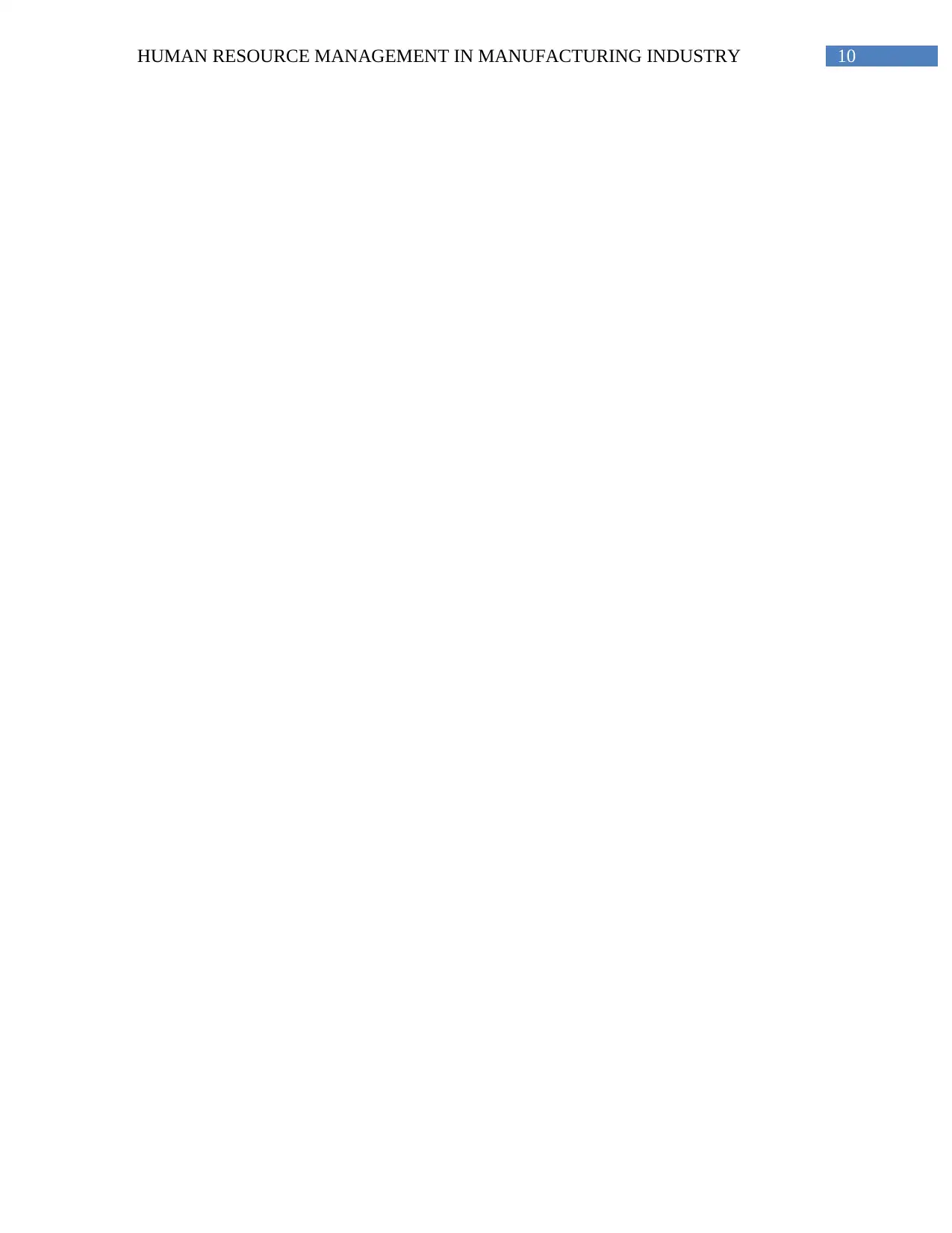
10HUMAN RESOURCE MANAGEMENT IN MANUFACTURING INDUSTRY

11HUMAN RESOURCE MANAGEMENT IN MANUFACTURING INDUSTRY
References
Aguenza, B.B. and Som, A.P.M., (2018). Motivational factors of employee retention and
engagement in organizations. IJAME.
Arnaboldi, M., Lapsley, I., & Steccolini, I. (2015). Performance management in the public
sector: The ultimate challenge. Financial Accountability & Management, 31(1), 1-22.
Aruna, M., & Anitha, J. (2015). Employee retention enablers: Generation Y employees. SCMS
Journal of Indian Management, 12(3), 94.
Aswathappa, K. E. M. A. L. (2013). Human resource management: Text and cases. Tata
McGraw-Hill Education.
Bach, S. (2013). Performance management. Managing human resources: Human resource
management in transition, 221-342.
Bansal, S. (2014). Employee retention strategies. International Journals of Research
Management and Social Sciences, 22, 62.
Bryant, P. C., & Allen, D. G. (2013). Compensation, benefits and employee turnover: HR
strategies for retaining top talent. Compensation & Benefits Review, 45(3), 171-175.
Canas, K., & Sondak, H. (2013). Opportunities and challenges of workplace diversity. Pearson
Higher Ed.
Cloutier, O., Felusiak, L., Hill, C., & Pemberton-Jones, E. J. (2015). The Importance of
Developing Strategies for Employee Retention. Journal of Leadership, Accountability &
Ethics, 12(2).
References
Aguenza, B.B. and Som, A.P.M., (2018). Motivational factors of employee retention and
engagement in organizations. IJAME.
Arnaboldi, M., Lapsley, I., & Steccolini, I. (2015). Performance management in the public
sector: The ultimate challenge. Financial Accountability & Management, 31(1), 1-22.
Aruna, M., & Anitha, J. (2015). Employee retention enablers: Generation Y employees. SCMS
Journal of Indian Management, 12(3), 94.
Aswathappa, K. E. M. A. L. (2013). Human resource management: Text and cases. Tata
McGraw-Hill Education.
Bach, S. (2013). Performance management. Managing human resources: Human resource
management in transition, 221-342.
Bansal, S. (2014). Employee retention strategies. International Journals of Research
Management and Social Sciences, 22, 62.
Bryant, P. C., & Allen, D. G. (2013). Compensation, benefits and employee turnover: HR
strategies for retaining top talent. Compensation & Benefits Review, 45(3), 171-175.
Canas, K., & Sondak, H. (2013). Opportunities and challenges of workplace diversity. Pearson
Higher Ed.
Cloutier, O., Felusiak, L., Hill, C., & Pemberton-Jones, E. J. (2015). The Importance of
Developing Strategies for Employee Retention. Journal of Leadership, Accountability &
Ethics, 12(2).
⊘ This is a preview!⊘
Do you want full access?
Subscribe today to unlock all pages.

Trusted by 1+ million students worldwide
1 out of 15
Related Documents
Your All-in-One AI-Powered Toolkit for Academic Success.
+13062052269
info@desklib.com
Available 24*7 on WhatsApp / Email
![[object Object]](/_next/static/media/star-bottom.7253800d.svg)
Unlock your academic potential
Copyright © 2020–2025 A2Z Services. All Rights Reserved. Developed and managed by ZUCOL.





